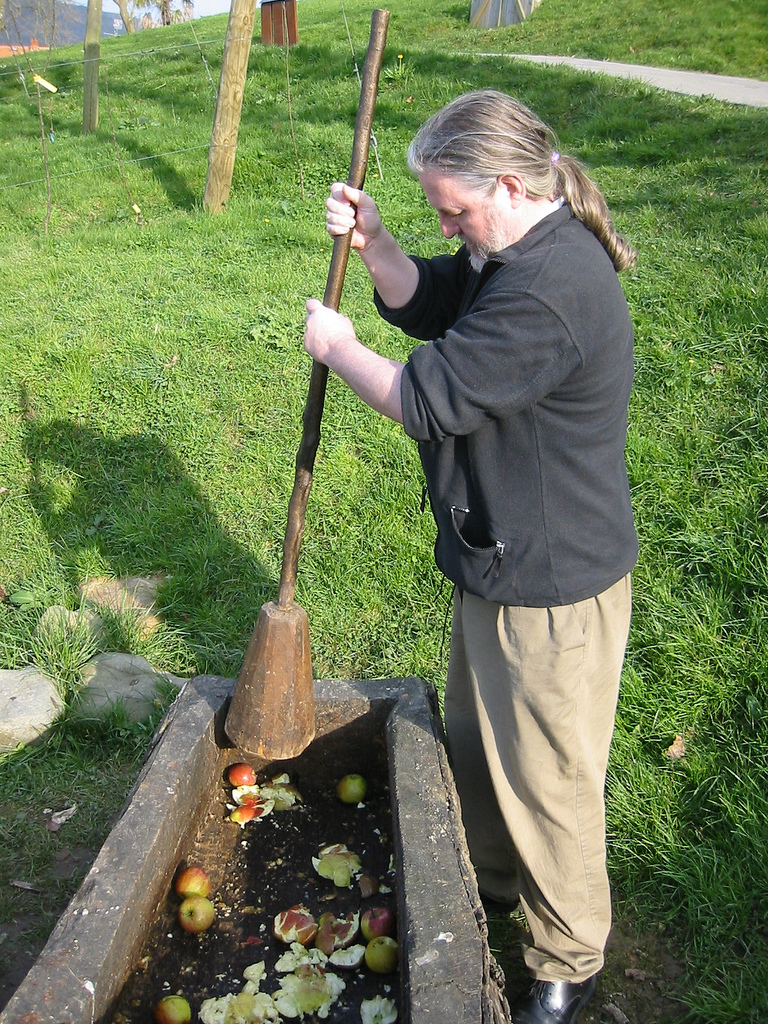
Come January, devotees gather for camaraderie, gastronomy and long evenings of imbibing
The Basque ciderhouse has been overshadowed by the more famous Spanish tapas bar. That’s all the more reason to visit one.
The sargardotegia melds apple (sagar), wine (ardo) and “a place where something happens,” or tegi. So, sargardotegia roughly translates as “the place where apple wine happens.”
The Basque fondness for apples shows up in documents dating back to the 11th century, when the King of Navarre praised the Basques for their cider-making talents. Basque whalers seem to have preferred cider to water during their long seafaring expeditions.
Traditionally, vast apple orchards were picked by the whole community. Apples would brought to the top floor of a two-story farm house and pressed, and the juice caught on the ground floor. The cider was then poured into large barrels, and left to ferment. The alcohol content, at 5% to 6%, is less than that of traditional hard cider, and more on par with beer.
Nowadays, machines do the pressing. But the process after smashing is the same: the juice goes into huge oak or chestnut barrels of about 250 gallons each. Fermenting turns the natural sugar to alcohol, and rids the apples of any sour taste.
Apple-picking takes place September through November. Cider-drinking season traditionally opens in mid January, when many sargardotegias open their doors, and let the cider fans in. The imbibing lasts through spring, or until the cider is gone.
A typical sargardotegia has a large dining room, where patrons normally eat standing up, and a kupela, or barrel room.
Originally sargardotegias were just for tasting: you’d sample cider from various barrels, and leave with bottles from the barrels you liked most.
Nowadays, a trip to the sargardotegias means dinner, and social event. But one still draws the cider straight from the barrel.
A ciderhouse meal always starts off with little pieces of txorizo - a sausage - and bread. Next comes a juicy cod omelet. Then more cod, but this time served with tasty green peppers. The next course is always a txuleta - a huge steak practically still bleeding, but oh so good. You’ll end with a dessert of strong Idiazabal cheese with membrillo, a quince jelly you cut into pieces and place on top of the cheese slices. This is served with nuts you crack yourself, either with your hand or against the table.
This filling meal is punctuated by many trips to the kupela to refill your cider glass. The trick to staying power: you decant only two or three sips of cider into your cup on each trip, drink up in the kupela room, and then return to the dining room for more eating and talking. This is why eating standing up makes lots of sense: it’s easier to tack across the room for another drink.
Cider production was practically moribund during the Spanish Civil War in the 1930s, when most people abandoned their orchards. The cider-drinking tradition also lost some popularity after the nearby Navarre region increased its production of wine. But since the invention of Sargardo Egun (Cider Day) in 1981, cider has made a huge comeback. Most cider is produced in Gipuzkoa, the province surrounding San Sebastian. Gipuzkoa turns out some 2.5 million gallons annually. Only 10% of this output is drunk in sargardotegias; the rest is bottled and sold in stores.
The two most important words of any Basque cider night are txotx (pronounced “chocha”), the cidermaker’s altert that he is opening a barrel, and to come and fill up your glass; and topa (pronounced “toe-pa”), the Basque way of saying cheers! My favorite cider word is azkena, or “last one,” which comes into play late in the evening. The cider is so delicious that you just have to have one more.
Visiting Ciderhouses in Basque Country
The town of Astigarraga, about five miles inland from San Sebastian, is Basque ciderhouse stronghold, with as many as two dozen establishments scattered through hill and dale.
Lizeaga. At Lizeaga, one of the oldest ciderhouses in the region, you can enjoy a traditional menu of chorizo cooked in cider; cod omelet; grilled beef steak; and Idiazabal cheese with walnuts and quince preserve. Open year-round. Gartziategi Baserria, 20115, Astigarraga. Tel: 34-943-468-290.
Petritegi Sagardoa. Busy, big Petritegi is open year round. Petritegi Bidea 20115, Astigarraga. Tel: 34-943 457-188.
Sidreria Donostiarra If you can’t get to the countryide, Sidreria Donostiarra, in the heart of San Sebastian’s old town, is a convenient place to enjoy the cider-drinking tradition. Cider is only sold, not produced, here. Calle Embeltran, 5, San Sebastian. Tel. 34-943-42-04-2.
A comprehensive guide to ciderhouses in Basque country.
Amanda Gonser writes and blogs from Spain’s Basque country.
What's your view?
You must be logged in to post a comment.




